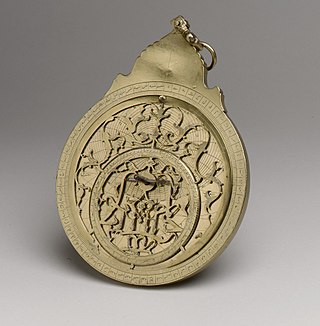
Brass is an alloy of copper (Cu) and zinc (Zn), in proportions which can be varied to achieve different colours and mechanical, electrical, acoustic, and chemical properties, but copper typically has the larger proportion. In use since prehistoric times, it is a substitutional alloy: atoms of the two constituents may replace each other within the same crystal structure.

Electrum is a naturally occurring alloy of gold and silver, with trace amounts of copper and other metals. Its color ranges from pale to bright yellow, depending on the proportions of gold and silver. It has been produced artificially and is also known as "green gold".

Orichalcum or aurichalcum is a metal mentioned in several ancient writings, including the story of Atlantis in the Critias of Plato. Within the dialogue, Critias says that orichalcum had been considered second only to gold in value and had been found and mined in many parts of Atlantis in ancient times, but that by Critias's own time, orichalcum was known only by name.

Patina is a thin layer that variously forms on the surface of copper, brass, bronze, and similar metals and metal alloys, or certain stones and wooden furniture, or any similar acquired change of a surface through age and exposure.
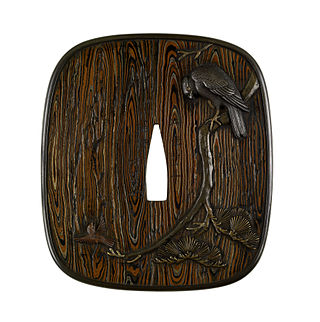
Mokume-gane (木目金) is a Japanese metalworking procedure which produces a mixed-metal laminate with distinctive layered patterns; the term is also used to refer to the resulting laminate itself. The term mokume-gane translates closely to 'wood grain metal' or 'wood eye metal' and describes the way metal takes on the appearance of natural wood grain. Mokume-gane fuses several layers of differently coloured precious metals together to form a sandwich of alloys called a "billet." The billet is then manipulated in such a way that a pattern resembling wood grain emerges over its surface. Numerous ways of working mokume-gane create diverse patterns. Once the metal has been rolled into a sheet or bar, several techniques are used to produce a range of effects.

Shakudō (赤銅) is a Japanese billon of gold and copper, one of the irogane class of colored metals, which can be treated to develop a black, or sometimes indigo, patina, resembling lacquer. Unpatinated shakudō visually resembles bronze; the dark color is induced by the niiro artificial patination process, involving boiling in a solution, generally including rokushō.
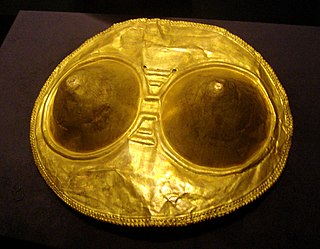
Tumbaga is the name for a non-specific alloy of gold and copper given by Spanish Conquistadors to metals composed of these elements found in widespread use in pre-Columbian Mesoamerica in North America and South America.
Rokushō (緑青) is a traditional Japanese chemical compound used in the niiro process for artificially inducing patination in decorative non-ferrous metals, especially several copper alloys, with the results being metals of the irogane class. These "colour metals," virtually unknown outside Japan until the late 19th century, have achieved some popularity in craft circles in other parts of the world since then.

Niello is a black mixture, usually of sulphur, copper, silver, and lead, used as an inlay on engraved or etched metal, especially silver. It is added as a powder or paste, then fired until it melts or at least softens, and flows or is pushed into the engraved lines in the metal. It hardens and blackens when cool, and the niello on the flat surface is polished off to show the filled lines in black, contrasting with the polished metal around it. It may also be used with other metalworking techniques to cover larger areas, as seen in the sky in the diptych illustrated here. The metal where niello is to be placed is often roughened to provide a key. In many cases, especially in objects that have been buried underground, where the niello is now lost, the roughened surface indicates that it was once there.

Shibuichi (四分一) is a historically Japanese copper alloy, a member of the irogane class, which is patinated into a range of subtle greys and muted shades of blue, green, and brown, through the use of niiro processes, involving the rokushō compound.
Kuromido is an historically Japanese copper alloy, typically of 99% copper and 1% metallic arsenic, one of the class of irogane metals.

Spelter is a zinc–lead alloy that ages to resemble bronze, but is softer and has a lower melting point. The name can also refer to a copper–zinc alloy used for brazing, or to pure zinc.

Panchaloha, also called Pañcadhātu, is a term for traditional five-metal alloys of sacred significance, used for making Hindu temple murti and jewelry.
Hepatizon, also known as black Corinthian bronze, was a highly valuable metal alloy in classical antiquity. It is thought to be an alloy of copper with the addition of a small proportion of gold and silver, mixed and treated to produce a material with a dark purplish patina, similar to the colour of liver. It is referred to in various ancient texts, but few known examples of hepatizon exist today.

Colored gold is the name given to any gold that has been treated using techniques to change its natural color. Pure gold is slightly reddish yellow in color, but colored gold can come in a variety of different colors by alloying it with different elements.
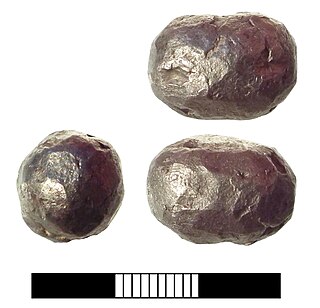
Metals and metal working had been known to the people of modern Italy since the Bronze Age. By 53 BC, Rome had expanded to control an immense expanse of the Mediterranean. This included Italy and its islands, Spain, Macedonia, Africa, Asia Minor, Syria and Greece; by the end of the Emperor Trajan's reign, the Roman Empire had grown further to encompass parts of Britain, Egypt, all of modern Germany west of the Rhine, Dacia, Noricum, Judea, Armenia, Illyria, and Thrace. As the empire grew, so did its need for metals.
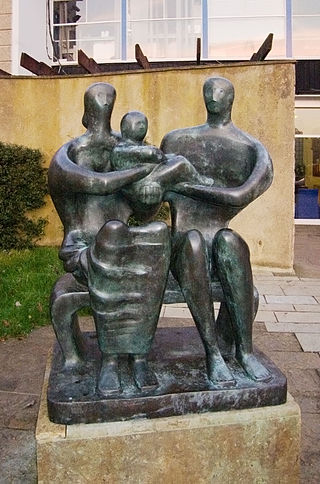
Chemical coloring of metals is the process of changing the color of metal surfaces with different chemical solutions.
Irogane is the term for a set of Japanese metals – forms of copper, and copper alloys – treated in niiro patination processes, traditionally used in sword-making, catches for sliding doors, and luxury highlights on larger objects, and in modern times, in jewellery. The alloys contain two to five metals. Some scholars believe that methods similar to those involved in irogane production may also have been used in ancient Egypt and the Roman world, as well as China and Tibet (dzne-ksim).
Niiro, also known as niiro-eki (煮色液), niiro-chakushoku (煮色着色), nikomi-chakushoku (煮込み着色) or niage (煮上げ) is an historically Japanese patination process, responsible for the colouration of copper and certain of its alloys, resulting in the irogane class of craft metals, including shakudo, shibuichi and kuromido. It is now practiced in a number of countries, primarily for the making of jewellery and decorative sword fittings, but also for material for hollowware and sculpture. Importantly, the same process operates differently on different metals so that a piece with multiple components can be treated in one patination session, developing a range of colours.














